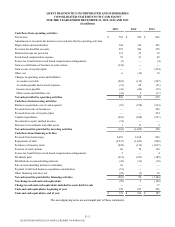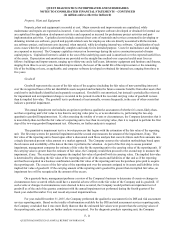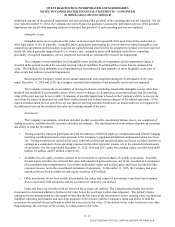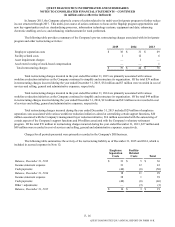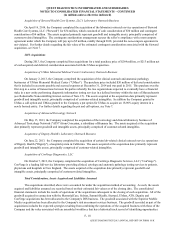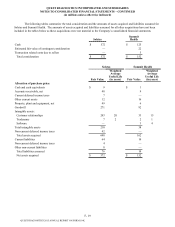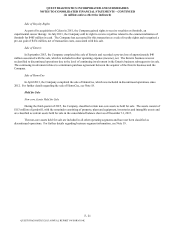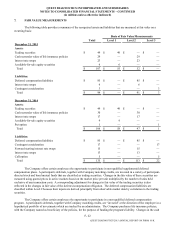Quest Diagnostics 2015 Annual Report Download - page 89
Download and view the complete annual report
Please find page 89 of the 2015 Quest Diagnostics annual report below. You can navigate through the pages in the report by either clicking on the pages listed below, or by using the keyword search tool below to find specific information within the annual report.QUEST DIAGNOSTICS INCORPORATED AND SUBSIDIARIES
NOTES TO CONSOLIDATED FINANCIAL STATEMENTS – CONTINUED
(in millions unless otherwise indicated)
F- 14
New Accounting Standards
In May 2014, the FASB issued an ASU on revenue recognition. This ASU outlines a single comprehensive model to
use in accounting for revenue arising from contracts with customers. This standard supersedes existing revenue recognition
requirements and eliminates most industry-specific guidance from GAAP. The core principle of the revenue recognition
standard is to require an entity to recognize as revenue the amount that reflects the consideration to which it expects to be
entitled in exchange for goods or services as it transfers control to its customers. The standard requires additional disclosures
including those that are qualitative and quantitative disclosures about the nature, amount, timing and uncertainty of revenue and
cash flows arising from contracts with customers. In August 2015, the FASB deferred the effective date of this ASU to the first
quarter of 2018, with early adoption permitted beginning in the first quarter of 2017. The ASU can be applied using a full
retrospective method or a modified retrospective method of adoption. The Company is currently assessing the impact of the
adoption of this ASU on the Company’s results of operations, financial position and cash flows.
In February 2015, the FASB issued an ASU which makes targeted amendments to the current consolidation guidance
for variable interest entities and limited partnerships and similar entities. The ASU is effective for the Company in the first
quarter of 2016 with the option of using a full retrospective or a modified retrospective method. The Company does not expect
the adoption of this standard to have a material impact on its results of operations, financial position and cash flows.
In April 2015, the FASB issued an ASU which requires that debt issuance costs be presented in the balance sheet as a
direct reduction to the carrying amount of the associated debt liability, consistent with debt discounts. The Company adopted
this standard in the second quarter of 2015 and applied the standard retrospectively. Adoption of this standard has resulted in
the reclassification of $20 million of unamortized debt issuance costs from other assets to a reduction of long-term debt on the
consolidated balance sheet at December 31, 2014.
In April 2015, the FASB issued an ASU which provides guidance in determining whether a cloud computing
arrangement includes a software license. If it is determined that a cloud computing arrangement does include a software
license, the software element of the arrangement should be accounted for consistent with the acquisition of other software
licenses. If the arrangement does not include a software license, it should be accounted for as a service contract. The ASU is
effective for the Company in the first quarter of 2016 and can be applied prospectively to all arrangements entered into or
materially modified after the effective date or retrospectively. The Company does not expect the adoption of this ASU to have a
material impact on its results of operations, financial position and cash flows.
In September 2015, the FASB issued an ASU which requires that an acquirer recognize adjustments to provisional
amounts in a business combination that are identified during the measurement period in the reporting period in which the
adjustment amounts are determined, including the cumulative effect of the change in provisional amount as if the accounting
had been completed at the acquisition date. The ASU is effective for the Company in the first quarter of 2016 and will be
applied prospectively to adjustments to provisional amounts after the effective date. The Company does not expect the
adoption of this ASU to have a material impact on its results of operations, financial position and cash flows.
In November 2015, the FASB issued an ASU which requires that all deferred income tax assets and liabilities be
classified as non-current in the balance sheet. The current requirement that deferred tax assets and liabilities of a tax-paying
component of an entity be offset and presented as a single amount is not affected by the new guidance. The Company adopted
this standard in the fourth quarter of 2015 and elected to apply the standard prospectively. As such, prior periods were not
retrospectively adjusted. Adoption of this standard resulted in $168 million of deferred taxes associated with current assets and
liabilities being classified as non-current deferred tax assets of $26 million and as a reduction of non-current deferred tax
liabilities of $142 million on the consolidated balance sheet as of December 31, 2015.
In January 2016, the FASB issued an ASU on the recognition and measurement of financial assets and financial
liabilities. This ASU requires that all equity investments (except those accounted for under the equity method of accounting or
those that result in consolidation of the investee) be measured at fair value with changes in fair value recognized in net income.
However, companies may elect to measure equity investments that do not have readily determinable fair values at cost minus
impairment, if any, plus or minus changes resulting from observable price changes in orderly transactions for the identical or a
similar investment of the same issuer. In addition, the ASU eliminates the requirement to disclose the method and significant
assumptions used to estimate the fair value for financial instruments measured at amortized cost on the balance sheet. The ASU
is effective for the Company in the first quarter of 2018. The Company does not expect the adoption of this ASU to have a
material impact on its results of operations, financial position and cash flows.
QUEST DIAGNOSTICS 2015 ANNUAL REPORT ON FORM 10-K



